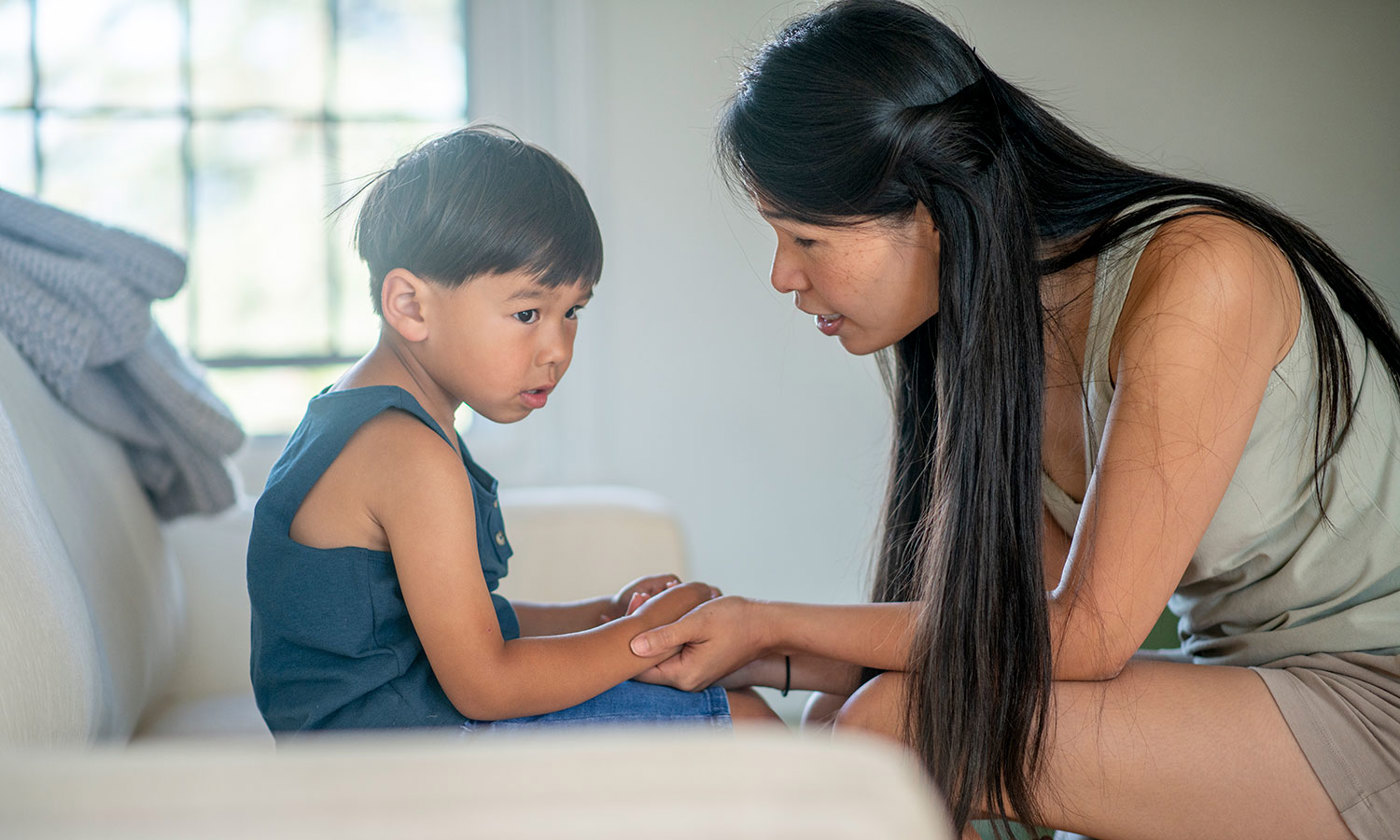Like what you see?
Sign up to receive more free parenting advice.
Thank you for subscribing to our newsletter!
Child Development

Credit: iStock.com/FatCamera
Dr Justin Coulson is the author of seven books about raising happy families, the host and parenting expert on Channel 9’s “Parental Guidance” and a dad of six children. In this article he explores six reasons why it can sometimes seem like our children are not listening to us and what we can do to connect with them.
Six reasons why our kids are not listening
1. They didn’t hear what we were saying
Kids have the ability to completely immerse themselves in something. They get 100% absorbed by the task they are doing, the toy they are playing with or even the screen they are watching.
In moments like this, it is very likely that our children simply cannot hear us, they may not even register that we are speaking to them.
Let’s give them the benefit of the doubt.
2. They don’t understand
While our children make great progress at that age, we need to remind ourselves that they are still learning, and we must consider that they may not understand what we are saying.
A perfect example of this was shared with me by a mother recently. She kept telling her daughter not to play at the corner out on the street as that’s where cars and trucks go past.
One day she finds her daughter doing just that. She storms out and yells, “How many times have I told you not to play at the corner?”.
Can you guess what her daughter’s answer was?
“Mummy, what’s a corner?”
3. Correction and direction rather than connection
Imagine you are in a relationship with someone and all they ever do is tell you what to do, how to do it, when to do it and why you’ve done it wrong.
Chances are you will get tired of being around that person! It is tiring and it makes you feel worthless.
As parents, we have the best of intentions when directing and correcting them, but what our children need most, especially if we want them to listen to us, is connection: feeling seen, heard and valued.
4. Timing
There is always an urgency when it comes to parental requests.
“Come and put your shoes on, pack your bag, bush your teeth…”
Our requests are all based on what our agenda is right here and right now.
Our children are often caught up in things that matter to them, and do much better with gentle transitions, better connections and soft reminders rather than urgency.
5. HALTS
When their needs regarding HALTS (Hunger, Anger, Loneliness, Tiredness or Stress) are not met, children are distracted and tend to not respond well to any of our requests.
Ultimately this is a question of connection. Our job as parents is to be sufficiently attuned to know if they may be feeling hungry, angry, lonely, tired or stressed.
6. It’s a power thing
“You’re not the boss of me!”
When we as parents start to get all steamed up and power hungry, sometimes they simply don’t listen because they want to show us that they can do the same thing.
We are modelling to them that power is everything, so we shouldn’t be surprised when they start throwing that back at us.
As parents, we have the best of intentions when directing and correcting them, but what our children need most, especially if we want them to listen to us, is connection: feeling seen, heard and valued.Dr Justin Coulson
Stay up to date with the latest news and articles from First Five Years
Thank you for subscribing to our newsletter!
Expert tips to get your child to listen to you
1. Be sure you have their attention
Instead of yelling from the kitchen into nothingness while our children are busy with other things, make sure they are looking at you. Make sure there is a connection between you, and they can actually hear you.
2. Actually connect
When your children receive an instruction from you, do they feel seen heard and valued?
To connect with our children, we need to:
- Stop what we’re doing
- Get on their level
- Look into their eyes
- Breathe with them and be present
3. Use as few words as possible
You don’t need to praise them, beg them or explain everything in detail.
Keep your instructions clear and simple. Give them their names and then one or two words of what’s expected.
“Annabel, your shoes.”
Keeping it short means giving your child credit for having a brain. They know what you mean!
4. Acknowledge our children’s feelings
Every now and then instead of them doing the thing, they will go into full meltdown mode.
When that happens you know that they are probably HALTS and what you are asking them is probably a little bit too much in that moment.
Here is the solution: emotion coaching. Name the emotion: if you name it, you can tame it. If it’s mentionable, it is manageable.
Show compassion – you see them in their suffering, and you join them in it. That makes all the difference.
The objective is for us to stay appropriately distanced emotionally while still being involved, caring and compassionate.
5. Offer choices
Research suggests that the more options there are, the more overwhelmed we feel and the less likely they are to make a choice.
At the same time our children thrive on autonomy – they want choice.
They key is to give them a choice, but to limit them. “Do you want to wear the green jumper or the red one? Do you want jam on toast or peanut butter?”
6. Give transition warnings frequently
Step your child through transition warnings pre-emptively.
Before going to the park, explain to your child that you will give transitions warnings and what they will mean. “When I say one minute to go, we’ll get ready to pack everything up and get into the car”.
Ask your child to repeat what you said: “When I say one minute to go, what do we do?”
When we give transition warnings, we give them the opportunity to feel safe, to predict and know what’s coming.
7. We need to adjust our expectations
The reality is, we are dealing with toddlers. They have extremely limited capacity for emotional and behavioural control.
As parents our job is to understand where they are at right now. They will get older, and it is our job to teach them.
8. We need to dump the “don’t”
When we say “don’t do this” “don’t do that” to our children, we give them two things to process:
- The thing that you want them to stop
- The thing you want them to do instead
We must learn to give instructions with a DO instead: “Don’t hit your sister” turns into “Be gentle with your sister”.
9. Get them to repeat what you asked them to do
The goal is to extract a commitment from your child.
“What was it that I asked you to do?”
“Do you want me to show you how?”
10. We need to be the example
If we need our kids to keep it together, we need to do the same.
Emotions are contagious.
Our children catch our crazy, but they also catch our calm.








